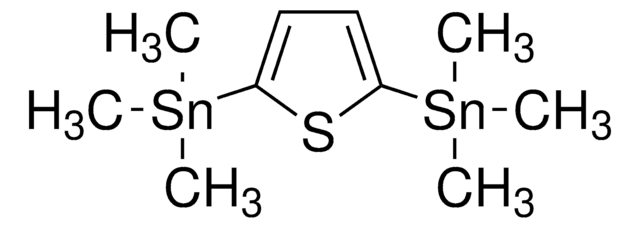759791
2,5-Dibromo-3,4-ethylenedioxythiophene
97%
Synonym(s):
5,7-Dibromo-2,3-dihydrothieno[3,4-b][1,4]dioxine
Sign Into View Organizational & Contract Pricing
All Photos(1)
About This Item
Empirical Formula (Hill Notation):
C6H4Br2O2S
CAS Number:
Molecular Weight:
299.97
MDL number:
UNSPSC Code:
12352103
PubChem Substance ID:
NACRES:
NA.23
Recommended Products
Assay
97%
form
solid
mp
95-100 °C
storage temp.
−20°C
SMILES string
Brc1sc(Br)c2OCCOc12
InChI
1S/C6H4Br2O2S/c7-5-3-4(6(8)11-5)10-2-1-9-3/h1-2H2
InChI key
FHMRWRBNAIDRAP-UHFFFAOYSA-N
General description
2,5-Dibromo-3,4-ethylenedioxythiophene (DBEDOT) is a monomer which is used in the synthesis of highly conducting poly(3,4-ethylenedioxythiophene) (PEDOT) polymer. This polymer is formed by solid-state polymerisation of DBEDOT and is used widely in organic-light emitting diodes and polymer field effect transistors. DBEDOT is a well-ordered crystalline monomer and produces PEDOT polymer which has a high degree of order.
Application
Used as a monomer in the synthesis of poly(3,4-ethylenedioxythiophene) (PEDOT) polymer which are used in electrochromic devices.
Features and Benefits
Polymerisation of DBEDOT can take place under very gentle conditions in the absence of external agents or catalysts.
Choose from one of the most recent versions:
Certificates of Analysis (COA)
Lot/Batch Number
Don't see the Right Version?
If you require a particular version, you can look up a specific certificate by the Lot or Batch number.
Already Own This Product?
Find documentation for the products that you have recently purchased in the Document Library.
Customers Also Viewed
Hong Meng et al.
Journal of the American Chemical Society, 125(49), 15151-15162 (2003-12-05)
Prolonged storage ( approximately 2 years) or gentle heating (50-80 degrees C) of crystalline 2,5-dibromo-3,4-ethylenedioxythiophene (DBEDOT) affords a highly conducting, bromine-doped poly(3,4-ethylenedioxythiophene) (PEDOT), as confirmed by solid-state NMR, FTIR, CV, and vis-NIR spectroscopies. The novel solid-state polymerization (SSP) does not
Synthesis and characterization of thiophene functionalized polystyrene copolymers and their electrochemical properties
Sahin, E., Camurlu, P., Toppare, L., Mercore, V. M., Cianga, I., & Yagci, Y.
Polymer International, 54(12), 1599-1605 (2005)
Minami Kato et al.
ChemSusChem, 13(9), 2379-2385 (2020-02-11)
Many types of batteries have been proposed as next-generation energy-storage systems. One candidate is a rocking-chair-type "molecular ion battery" in which a molecular ion, instead of Li+ , works as a charge carrier. Previously, we reported a viologen-type derivative as
Our team of scientists has experience in all areas of research including Life Science, Material Science, Chemical Synthesis, Chromatography, Analytical and many others.
Contact Technical Service

![2-Chloromethyl-2,3-dihydrothieno[3,4-b]-1,4-dioxine 95%](/deepweb/assets/sigmaaldrich/product/structures/422/187/4cc7b858-9e06-4ce2-8d39-d817b8313964/640/4cc7b858-9e06-4ce2-8d39-d817b8313964.png)
![1,1′-[4,8-Bis[5-(2-ethylhexyl)-2-thienyl]benzo[1,2-b:4,5-b′]dithiophene-2,6-diyl]bis[1,1,1-trimethylstannane]](/deepweb/assets/sigmaaldrich/product/structures/611/912/a638a6fe-ca7b-4674-8023-df4c0921a9fd/640/a638a6fe-ca7b-4674-8023-df4c0921a9fd.png)

![2,5-Bis(trimethylstannyl)-thieno[3,2-b]thiophene 97%](/deepweb/assets/sigmaaldrich/product/structures/126/532/26557e94-858e-4c96-90de-ca88d84a8727/640/26557e94-858e-4c96-90de-ca88d84a8727.png)



![4,9-Dibromo-2,7-bis(2-octyldodecyl)benzo[lmn][3,8]phenanthroline-1,3,6,8(2H,7H)-tetrone](/deepweb/assets/sigmaaldrich/product/structures/100/693/87f6ccae-153b-4ba6-bd0a-653ba06ece22/640/87f6ccae-153b-4ba6-bd0a-653ba06ece22.png)




